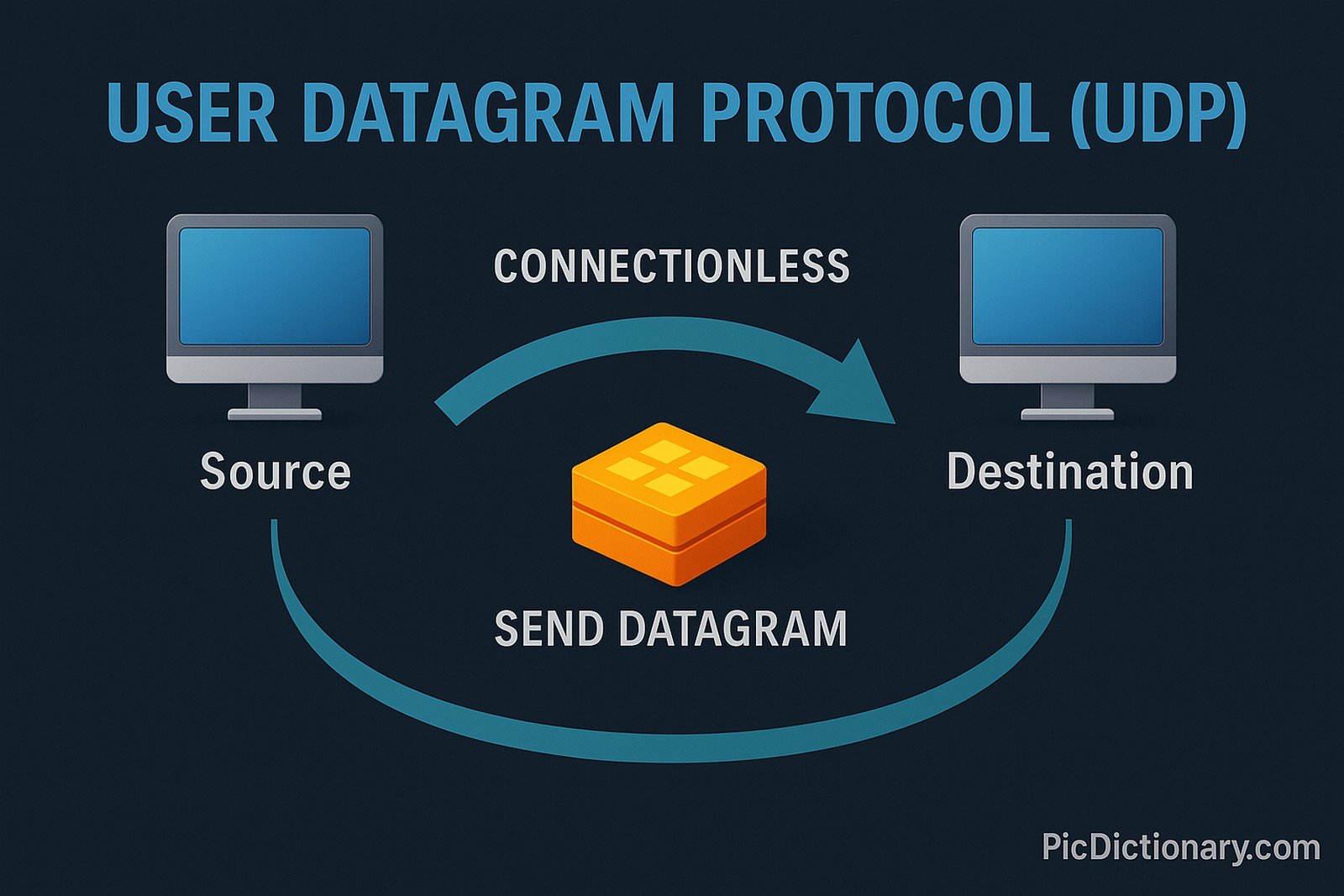User Datagram Protocol (UDP)

Quick Navigation:
- User Datagram Protocol (UDP) Definition
- User Datagram Protocol (UDP) Explained Easy
- User Datagram Protocol (UDP) Origin
- User Datagram Protocol (UDP) Etymology
- User Datagram Protocol (UDP) Usage Trends
- User Datagram Protocol (UDP) Usage
- User Datagram Protocol (UDP) Examples in Context
- User Datagram Protocol (UDP) FAQ
- User Datagram Protocol (UDP) Related Words
User Datagram Protocol (UDP) Definition
User Datagram Protocol (UDP) is a communication protocol used in computer networks that allows data to be sent without establishing a direct connection between devices. It is connectionless and focuses on speed, transmitting data packets (datagrams) without checking if they arrive successfully. This makes UDP ideal for real-time applications like online gaming, live streaming, and voice-over-IP calls, where speed is prioritized over reliability. Unlike TCP, UDP does not perform error correction or sequencing, which reduces overhead and increases data transfer rates.
User Datagram Protocol (UDP) Explained Easy
Imagine sending a postcard to a friend without asking them if they received it. You just write, stamp, and send — no follow-up. UDP works like that: it sends small packets of information quickly without checking if they arrive or if they’re in the right order. This helps things move faster, perfect for video calls or online games where speed is more important than perfection.
User Datagram Protocol (UDP) Origin
UDP was introduced in 1980 as part of the Internet Protocol Suite. Developed by David P. Reed, it provided an alternative to TCP, offering a lightweight protocol suitable for time-sensitive communications that don't require guaranteed delivery.
User Datagram Protocol (UDP) Etymology
The term "datagram" refers to self-contained packets of information sent independently across a network. The "user" part emphasizes its focus on end-to-end communication without intermediary management.
User Datagram Protocol (UDP) Usage Trends
UDP usage has consistently grown with the rise of streaming services, online gaming, and real-time communications. Its simplicity and speed make it a preferred protocol for DNS queries, VoIP calls, and video conferencing. As internet speeds have increased, reliance on UDP for live content delivery has also grown.
User Datagram Protocol (UDP) Usage
- Formal/Technical Tagging:
- Networking
- Communication Protocols
- Internet Technology - Typical Collocations:
- "UDP packet"
- "UDP header"
- "UDP transmission"
- "UDP socket communication"
User Datagram Protocol (UDP) Examples in Context
- Online multiplayer games use UDP to send quick position updates between players.
- DNS queries often use UDP for faster resolution times.
- Live video streaming platforms rely on UDP for uninterrupted, low-latency transmission.
User Datagram Protocol (UDP) FAQ
- What is User Datagram Protocol (UDP)?
UDP is a connectionless network protocol that transmits data packets without checking for errors or delivery confirmation. - How does UDP differ from TCP?
UDP is faster but less reliable than TCP, as it does not establish connections or verify packet delivery. - Why is UDP used in gaming?
Because speed is crucial in gaming, UDP transmits data with minimal delay, even if some packets are lost. - Can UDP be used for file transfers?
It can, but it's not recommended due to lack of error correction; TCP is preferred for reliable file transfers. - What applications commonly use UDP?
Applications include online gaming, VoIP, DNS queries, and live video streaming. - Is UDP secure?
UDP itself does not have security features but can be used with encryption protocols for secure transmission. - How does UDP handle data order?
UDP does not guarantee the order of packet delivery; it's up to the application to manage sequencing if needed. - Does UDP support retransmission?
No, UDP does not retransmit lost packets; it prioritizes speed over reliability. - Can UDP be blocked by firewalls?
Yes, some firewalls block UDP due to its potential for misuse, although it’s widely allowed for legitimate use. - How large can a UDP packet be?
The maximum size of a UDP datagram is 65,535 bytes, including headers.

User Datagram Protocol (UDP) Related Words
- Categories/Topics:
- Networking
- Data Transmission
- Communication Protocols
- Real-Time Applications
Did you know?
In 2020, Google’s QUIC protocol — designed for faster web traffic — was built on top of UDP, demonstrating how this simple, fast protocol remains relevant and adaptable even in modern, complex internet technologies.
PicDictionary.com is an online dictionary in pictures. If you have questions or suggestions, please reach out to us on WhatsApp or Twitter.Authors | Arjun Vishnu | @ArjunAndVishnu

I am Vishnu. I like AI, Linux, Single Board Computers, and Cloud Computing. I create the web & video content, and I also write for popular websites.
My younger brother, Arjun handles image & video editing. Together, we run a YouTube Channel that's focused on reviewing gadgets and explaining technology.



Comments powered by CComment